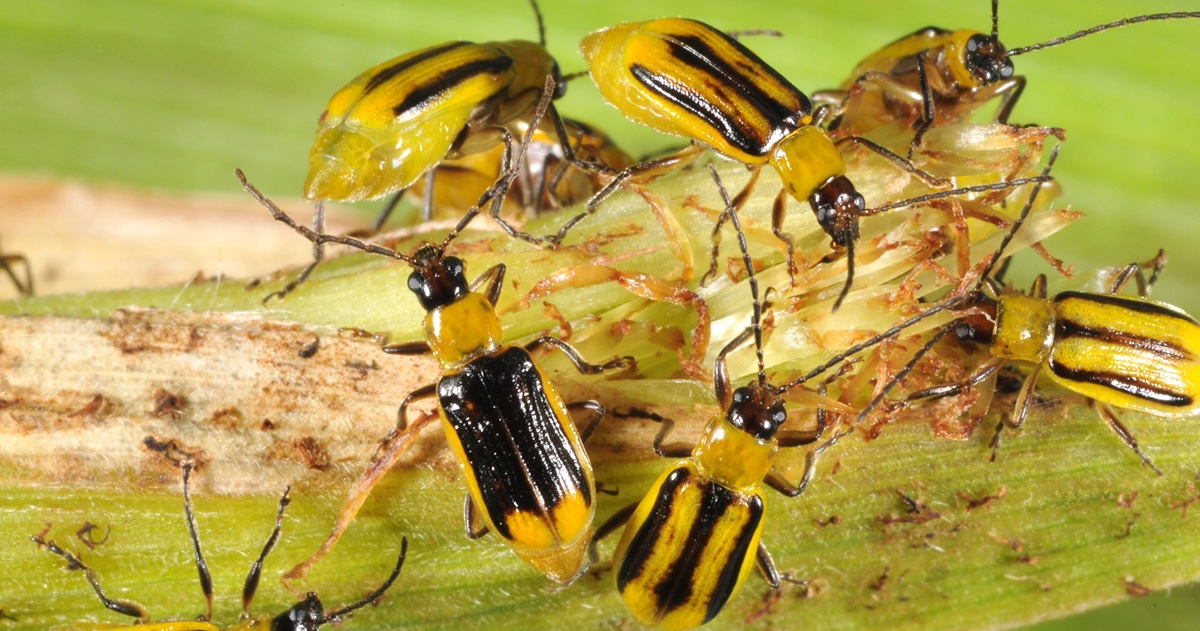Midwestern field trials suggest overuse of rootworm-resistant corn reduces farmers’ profits
Corn that has been genetically engineered to resist corn rootworms like this one has become increasingly less effective. Purdue University entomologist Christian Krupke and his colleagues at 12 universities publish a multi-state analysis of the problem in the journal Science. (Purdue University Extension Entomology/John Obermeyer)
Researchers advocate new approach for managing innovative hybrid technologies
WEST LAFAYETTE, Ind. — An analysis of data covering 12 years and 10 U.S. Corn Belt states reveals that farmers suffer economic loss from the overuse of genetically engineered corn designed to combat rootworm pests.
Christian Krupke, a Dean’s Fellow and professor of entomology at Purdue University, and 19 co-authors from 12 other universities in the U.S., China and Canada reported their results in the most recent issue of the journal Science. The retrospective study demonstrated that the pest landscape has fundamentally changed in many key corn-growing areas of the U.S. since 2004, the initial year of broad adoption of transgenic corn hybrids targeting corn rootworms. The study shows pest pressures in much of the region declined dramatically following introduction of these hybrids, reducing the need for broad deployment of the rootworm-specific traits.
The project, led by Krupke, documented greater rootworm pest pressure in the Corn Belt states of Illinois, Iowa, Minnesota, Nebraska, North Dakota, South Dakota and Wisconsin. In these states, farmers more commonly plant corn continuously. In the eastern Corn Belt states of Indiana, Michigan and Ohio, as well as in other states, farmers practice crop rotation that reduces the need for control through genetically engineered seed or applied insecticides.
However, the use of transgenic corn hybrids targeting rootworm pests has been remarkably similar across the entire region. This study explored the consequences of this disconnect.
“This study shows the value of long-term, applied research datasets from public sector field research,” Krupke said. The short duration and shifting priorities of research funding streams make it increasingly rare to have such scope and coverage in biological data. “These are among the most useful types of data for developing policy recommendations.”
In 2003, scientists introduced the first genetically engineered corn hybrid trait lethal to corn rootworms and derived from the bacterium Bacillus thuringiensis (Bt). Since then, farmers have extensively used Bt corn hybrids. Subsequently, multiple field studies have reported Bt resistance in rootworms since 2009, raising doubts about the long-term viability of the Bt traits.
The study emerged from observations made by a working group of corn entomologists who meet annually to discuss the impact of pests on the commodity. Several years ago, Krupke noticed a difference between corn rootworm reports in the eastern and western Corn Belt states.
“We were all in different regions of the country, yet doing much the same thing,” Krupke said. “We were still managing the pest using Bt hybrids as if rootworm was a prime driver of yield loss in states like Indiana. It wasn’t and it hadn’t been for some time.
From 2014 to 2016, yield losses attributed to rootworm damage amounted to 47.5 bushels per acre in western states and 8.5 bushels per acre in eastern states, the researchers estimated.

Corn that has been genetically engineered to resist corn rootworms like this one has become increasingly less effective. Purdue University entomologist Christian Krupke and his colleagues at 12 universities publish a multi-state analysis of the problem in the journal Science. (Purdue University Extension Entomology/John Obermeyer)
The study quantified the two costs of using the Bt hybrid. One cost was the substantial technology fee, a premium growers pay when buying the seed. The other cost was the erosion of pest susceptibility to the Bt toxin.
“If you think of a Bt hybrid as a finite resource, like a declining debit card, every time you use it, you erode a little bit of susceptibility,” Krupke said. “So, it’s a little less likely that it will work as well next time.”
For their part, growers select elite hybrid seed genetics that will produce the best yields. Those hybrids often bundle a variety of other desirable traits, including expression of multiple Bt toxins, whether they are needed or not.
Christina DiFonzo, a professor and field crops entomologist at Michigan State University, compared bundling seed traits to the packages formerly offered for cable TV. Consumers paid for hundreds of channels when they only wanted 10 or 15. Streaming services and on-demand programming have ended that. “Farmers would welcome a similar ‘pick list’ for the seed supply, and that would help insect resistance management.”
The key difference is that insect-resistant corn carries an ongoing collateral price to pay along with out-of-pocket costs. “Money can be replaced but loss of susceptibility to the technology only goes in one direction and is irreversible,” DiFonzo said.
These lessons should be applied to as-yet undefined transgenic trait technologies for in-plant protection, said the study’s lead author, Ziwei Ye, assistant professor at the School of Agricultural Economics and Rural Development at Renmin University of China. She advised against going back to insecticides, such as organophosphates and pyrethroids, for rootworm control.
“The Bt technology is and was a net benefit that helps safeguard beneficial organisms and soil ecosystems and enhance drought tolerance,” Ye said. “These are increasingly appreciated as key resources in feeding the growing world population as our climate changes.”
Bt and antibiotics are both examples of the “biological commons.” Individuals may perceive that it makes sense to use them as insurance, even when risk of harm from the pest seems limited. If many growers do this over a long period, resistance will set in and the technology’s decline will affect them all.
“Overusing Bt may make sense for each individual, but all will eventually lose the technology sooner than might have been the case,” said study co-author David Hennessy, the Cargill Professor in Economic Systems at Iowa State University. “Essentially, each individual does not take account of the harm done to others due to the buildup of genetic resistance to the toxin.”
Farmers thus have tended to use too much of Bt seed targeting rootworms for their bottom-line profit, especially in the eastern Corn Belt.
“In many cases, they overuse the input not just for the common good but also for their own private benefit,” Hennessy said. Simply alerting farmers to focus on comparing the financial costs and benefits to themselves when using the rootworm Bt trait might help protect the trait’s future effectiveness.
The use of transgenic technologies such as Bt maize as a key pest-management tool is likely to continue, Krupke noted. The technology is both user-friendly for growers and reduces insecticide applications.
“To keep this and future, similar technologies around and functional for the long-term is in everyone’s best interest,” he said.
This work received support from the State Agricultural Experiment Station from the Hatch Multistate Research Fund provided by the National Institute for Food and Agriculture (NIFA project NC246: Ecology and Management of Arthropods in Corn).
About Purdue Agriculture
Purdue University’s College of Agriculture is one of the world’s leading colleges of agricultural, food, life and natural resource sciences. The college is committed to preparing students to make a difference in whatever careers they pursue; stretching the frontiers of science to discover solutions to some of our most pressing global, regional and local challenges; and, through Purdue Extension and other engagement programs, educating the people of Indiana, the nation and the world to improve their lives and livelihoods. To learn more about Purdue Agriculture, visit this site.
About Purdue University
Purdue University is a public research university leading with excellence at scale. Ranked among top 10 public universities in the United States, Purdue discovers, disseminates and deploys knowledge with a quality and at a scale second to none. More than 107,000 students study at Purdue across multiple campuses, locations and modalities, including more than 58,000 at our main campus in West Lafayette and Indianapolis. Committed to affordability and accessibility, Purdue’s main campus has frozen tuition 13 years in a row. See how Purdue never stops in the persistent pursuit of the next giant leap — including its comprehensive urban expansion, the Mitch Daniels School of Business, Purdue Computes and the One Health initiative — at https://www.purdue.edu/president/strategic-initiatives.
Writer: Steve Koppes
Media contact: Devyn Ashlea Raver, draver@purdue.edu
Sources: Christian Krupke, ckrupke@purdue.edu
Agricultural Communications: Maureen Manier, mmanier@purdue.edu, 765-494-8415
Journalist Assets: Publication-quality photos can be obtained at this link.














